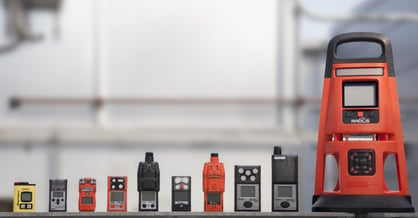Hydrogen Chloride (HCl) Gas Detectors
Most hydrogen chloride (HCl) is used in the production of hydrochloric acid. It is also an important reagent in other industrial chemical transformations, such as the hydrochlorination of rubber and the production of vinyl and alkyl chlorides. Other industries or applications where high levels of hydrogen chloride may occur include petrochemical facilities, cotton production, metal pickling, rubber manufacturing, and semiconductor production.
.webp?width=600&height=400&name=steel%20(1).webp)
Characteristics of Hydrogen Chloride
Hydrogen Chloride is a colorless to slightly yellow corrosive gas with a pungent, irritating odor. Although not considered a combustible gas, it may react or form combustible compounds when contact is made with alcohol and hydrogen cyanide or with aluminum-titanium alloys. Dissolving Hydrogen chloride in water will yield a strong highly corrosive acid. It is for this reason that HCl is a strong irritant to the eyes, nose, and upper respiratory tract. Levels of 35 ppm can cause irritation to the throat even after a very short period of time.
More about Hydrogen Chloride


HYDROGEN CHLORIDE - HCl
Effects of Various HCl Levels
Frequently Asked Questions
What is Hydrogen chloride (HCl)?
Hydrogen chloride (HCl) is a colorless, corrosive gas with a pungent odor. When dissolved in water, it forms hydrochloric acid, a strong acid widely used in industry. HCl is employed in various applications, including metal refining, pH control, and chemical synthesis. It is also a byproduct of certain industrial processes.
Why is Hydrogen chloride (HCl) detection important?
Hydrogen chloride (HCl) detection is crucial for ensuring safety in industrial environments. HCl is highly corrosive and can cause severe respiratory issues, skin burns, and eye damage. Detecting HCl leaks or emissions helps prevent harmful exposure, protects workers, and ensures compliance with environmental regulations.
What are the health effects of Hydrogen chloride (HCl) exposure?
Exposure to Hydrogen chloride (HCl) can have serious health effects. Inhalation can cause throat irritation, coughing, and shortness of breath. High concentrations may lead to pulmonary edema and respiratory failure. Skin contact can result in severe burns, while eye exposure can cause permanent damage. Chronic exposure may lead to long-term respiratory issues.
How do you detect Hydrogen chloride (HCl)?
Hydrogen chloride (HCl) is detected using various types of sensors and detectors. Common methods include electrochemical sensors, which provide real-time monitoring and are often used in portable devices. Infrared and colorimetric sensors are also employed for accurate detection. These devices are essential for maintaining safe levels of HCl in industrial and laboratory settings. Industrial Scientific also offers a range of HCl detectors, including portable gas detectors and gas monitoring software systems.


